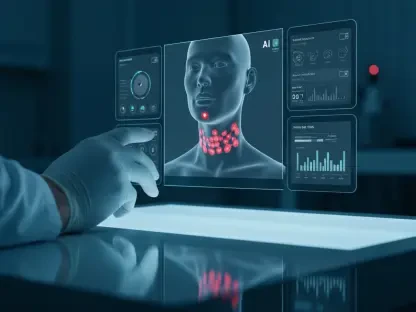The recent FDA Fast Track designation for BR55, developed by Bracco Imaging, marks a significant milestone in the diagnostic imaging industry. This novel molecular imaging ultrasound contrast agent specifically targets vascular endothelial growth factor receptor 2 (VEGFR2), a receptor highly expressed in areas undergoing angiogenesis. This designation underscores BR55’s potential to revolutionize the diagnosis and monitoring of Crohn’s disease, a chronic and relapsing inflammatory condition of the gastrointestinal tract. By streamlining the diagnostic process and offering more precise insights into disease activity, BR55 could significantly improve patient outcomes and advance therapeutic strategies effectively.
The Role of Angiogenesis in Crohn’s Disease
Crohn’s disease significantly impacts the gastrointestinal (GI) tract through chronic inflammation and angiogenesis, where inflammation promotes the formation of new blood vessels, further exacerbating tissue inflammation. This cyclical relationship between angiogenesis and inflammation highlights the need for effective and precise monitoring of the disease’s progression to ensure successful patient management. Understanding the role of angiogenesis is crucial in tackling the effects of Crohn’s disease because targeting these new blood vessels can potentially mitigate the continuing cycle of inflammation.
BR55 aims to target the vascular endothelial growth factor receptor 2 (VEGFR2), which is highly expressed in diseases undergoing angiogenesis, such as Crohn’s disease. By enhancing the ultrasound signal in these locations, BR55 aids in the detection and evaluation of inflammatory conditions and cancer. This ability is particularly crucial for Crohn’s disease, where monitoring disease activity is essential even when clinical symptoms are not evident. Detecting inflammation without relying solely on symptoms can prevent severe complications and progressive bowel damage, making BR55 a game-changer in diagnostic imaging.
FDA Fast Track Designation: A Step Forward
The FDA’s Fast Track designation for BR55 emphasizes its potential to address unmet medical needs in Crohn’s disease management. This designation helps expedite the development and review of BR55, which is vital for a condition where persistent active inflammation can lead to progressive bowel damage, severe complications, and disability. Precise and timely detection of inflammation is imperative for effective management, allowing physicians to adjust treatments proactively and fine-tune patient care strategies.
Phase 2 studies have demonstrated more than 95% accuracy for BR55-enhanced ultrasound imaging in determining VEGFR2 expression across various cancer tissues, including breast, ovarian, and thyroid. These promising results also apply to identifying active inflammation in Crohn’s disease, suggesting that BR55 could significantly improve traditional diagnostic modalities, which often involve more invasive procedures and reliance on symptomatic manifestations. Such advancements offer hope for reducing patient trauma and increasing diagnostic accuracy in clinical practice, paving the way for its elevated consideration in healthcare systems.
Broader Implications of BR55
Beyond Crohn’s disease, BR55’s ability to precisely identify VEGFR2 expression benefits a wide range of oncological and inflammatory conditions. This advancement positions Bracco Imaging as a leader in leveraging microbubble technology to enhance diagnostic imaging efficiency and accuracy. The use of BR55 promotes less invasive, portable, and radiation-free techniques, which hold substantial promise in the context of emerging therapies. As diseases and treatment approaches evolve, the necessity for cutting-edge diagnostic tools like BR55 becomes more pronounced, heralding a new era in medical imaging and patient care.
New drugs and biologics targeting Crohn’s disease require precise monitoring tools to evaluate treatment efficacy continually. Molecular imaging techniques employing BR55 can markedly elevate the standard of care by providing detailed insights into angiogenesis and inflammatory activity in real-time. This capability is crucial for improving patient outcomes and advancing therapeutic strategies, offering physicians deeper understanding into the effectiveness of novel therapies. Consequently, BR55 stands to become an indispensable tool in personalized medicine, enabling tailored and highly effective treatment plans for Crohn’s disease and beyond.
The Path to Phase 3 Studies
Alberto Spinazzi, MD, Chief Medical and Regulatory Officer at Bracco Imaging, highlights the profound impact of the Fast Track designation. He underscored the importance of providing timely and accurate tools for diagnostic imaging to improve patient management. Bracco Imaging is now preparing to launch large-scale Phase 3 studies to further validate BR55’s safety and efficacy. These comprehensive studies will be pivotal in confirming BR55’s capability to both detect angiogenesis and offer detailed insights into active inflammation in Crohn’s disease, ultimately setting new benchmarks in patient management protocols.
These studies aim to confirm BR55’s capability not only for detecting angiogenesis but also for providing detailed insights into active inflammation in Crohn’s disease. The goal is to establish a new benchmark in patient management protocols, redefining how inflammation and angiogenesis are mapped and monitored in clinical settings. Such advancements in diagnostic accuracy will ensure that patients receive pertinent treatment plans swiftly, minimizing the risk of complications and enhancing overall care quality.
The Interplay of Angiogenesis and Inflammation
The recognition of angiogenesis as a dual component in the pathogenesis of chronic inflammatory conditions, such as inflammatory bowel diseases, aligns with existing clinical evidence. Studies indicate that persistent inflammation and successive angiogenesis are mutually reinforcing processes. Monitoring angiogenesis serves as a surrogate marker for inflammation and vice versa, suggesting that targeting either process therapeutically might improve disease outcomes. By providing a precise picture of these processes, BR55 opens new possibilities for simultaneously diagnosing and managing inflammatory and oncological diseases.
Research from multiple studies has corroborated the central role of VEGFR2 and endothelial cells in fostering the angiogenic pathways linked with chronic inflammation. These insights support the development of BR55 as a critical agent that can substantially influence the diagnostic and therapeutic frameworks for Crohn’s disease and other related conditions. Understanding these interactions underpins the relevance of targeting angiogenesis, adding substantial value to BR55’s application in clinical settings, and reinforcing its potential as a transformative diagnostic tool in the medical community.
Conclusion
The FDA’s recent Fast Track designation for BR55, an innovative ultrasound contrast agent from Bracco Imaging, represents a major advance in diagnostic imaging. BR55 is a molecular imaging agent that specifically targets vascular endothelial growth factor receptor 2 (VEGFR2), a receptor highly expressed in areas of angiogenesis. This designation highlights BR55’s potential to transform the diagnosis and management of Crohn’s disease, a chronic, relapsing inflammatory condition of the gastrointestinal tract. By making the diagnostic process more efficient and providing detailed insights into disease activity, BR55 could significantly enhance patient outcomes and improve therapeutic strategies. This advancement promises to streamline early detection and offer precise monitoring, thus leading to better-targeted treatments and more effective management of Crohn’s disease. Overall, the Fast Track status of BR55 could herald a new era of innovation in diagnostic imaging and personalized medicine.









